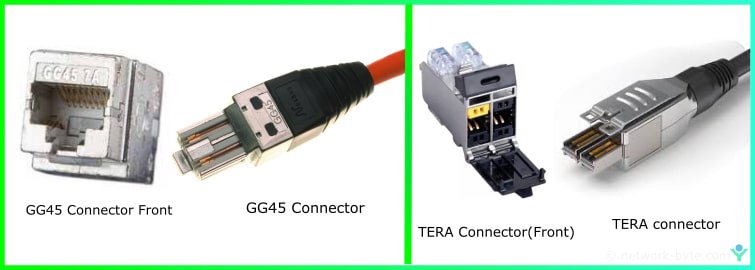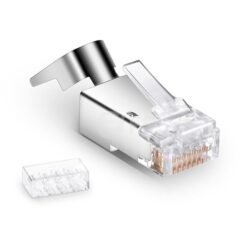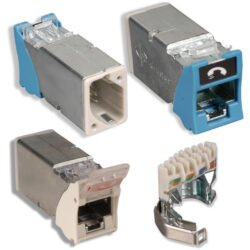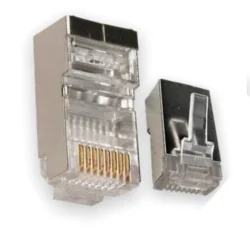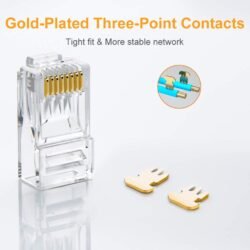Beyond RJ45: Ethernet Connector Types Explained
When most people think of ethernet connectors, the familiar RJ45 connector immediately comes to mind. It’s the standard 8P8C (8-position, 8-contact) connector found on nearly every network cable in homes and offices worldwide. However, the world of ethernet connectors extends far beyond the ubiquitous RJ45, encompassing specialized solutions designed for high-performance data centers, industrial environments, and next-generation networking applications.
This comprehensive guide explores the diverse landscape of ethernet connectors, helping you understand when and why different connector types are used, and how to select the right solution for your specific networking requirements.
RJ45: The Standard Ethernet Connector
Classification: It is technically an 8P8C (8-position, 8-contact) modular connector.
Performance: It supports speeds from 10 Mbps up to 10 Gbps (when used with Cat6A/Cat7 cabling).
Key Features: It’s used with both Unshielded (UTP) and Shielded (STP) Twisted Pair cables and is widely adopted due to its cost-effectiveness, ease of installation, and universal compatibility with most network equipment (switches, routers, computers).
Limitation: Signal integrity can degrade at frequencies above 600 MHz, and its plastic housing lacks the durability needed for harsh industrial or outdoor environments.
RJ45 Connectors
Advanced Ethernet Connectors Explained
| Connector Type | Key Benefit | Technical Specs | Best Use Cases |
| GG45 | Future-Proof High-Speed | Up to 2000 MHz; 12 contacts (8 standard + 4 corner); Supports 25G/40GBASE-T. | High-speed server links, Data Centers requiring backward compatibility and reduced crosstalk. |
| TERA | Max Signal Integrity/Shielding | Up to 1000 MHz (Cat7/7A); Four separate contact assemblies; 360-Degree Shielding. | High-density environments, extremely noisy conditions, high-performance links where alien crosstalk must be eliminated. |
| M12 | Industrial Ruggedness | IP67 Rating (dust/water); Wide Temperature Range (−40∘C to +85∘C); Vibration Resistant. | Factory Floors, Industrial IoT, Robotics, Outdoor installations, and Transportation systems (rail, automotive). |
Where Non-RJ45 Connectors Are Essential
- Data Centers: Need GG45 or TERA for:
- Massive Bandwidth (25G, 40G, and higher).
- Signal Integrity in High-Density deployments.
- Mission-critical reliability.
- Factories & Industrial Automation: Rely on M12 for:
- Survival in harsh environments (oil, coolants, vibration, extreme temperatures).
- Mission-Critical Reliability (single failure can halt production).
- Specialized Applications:
- Transportation: M12 for shock/vibration resistance (Rail, Automotive, Aviation).
- Outdoor/Remote: M12 for weather and UV protection (Telecom, Solar/Wind Farms).
- Military/Aerospace: Enhanced shielding and security features.
Choosing the Right Connector: Decision Framework
| Factor | RJ45 | GG45 / TERA | M12 |
| Performance Needs | Standard (1-10 Gbps) | High-Speed (25-40 Gbps), High-Frequency | Rugged/Durable Connection |
| Environment | Indoor, Temperature-Controlled Office | High-Density Data Center | Industrial, Outdoor, Harsh Conditions (IP67) |
| Installation | Easy; Basic Tools | Moderate Training; Specialized Tools | Requires Industrial Experience |
| Cost | Lowest Initial Investment | Premium Pricing Justified by Performance | Higher Initial Cost Justified by Reliability |
Conclusion
The world of ethernet connectors extends far beyond the familiar RJ45, encompassing specialized solutions like GG45, TERA, and M12 that meet demanding requirements of modern networking. While RJ45 connectors remain the backbone of most enterprise networks, understanding advanced connector technologies enables informed decisions that significantly impact network performance and reliability. As speeds increase and applications become more demanding, data centers pushing bandwidth boundaries, industrial facilities requiring harsh-environment connectivity, and specialized applications all benefit from enhanced capabilities that advanced ethernet connectors provide.
Ready to upgrade your network infrastructure? Shop our complete selection of RJ45 connectors and professional crimp tools to ensure reliable, high-performance ethernet connections for your next project. Our expert team can help you select the right connector solutions for your specific application requirements.
You can also,
Browse Ethernet Cables Compatible with Your Connector
Check out this Ultimate guide for ethernet cables in kenya


